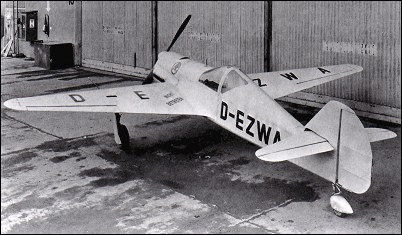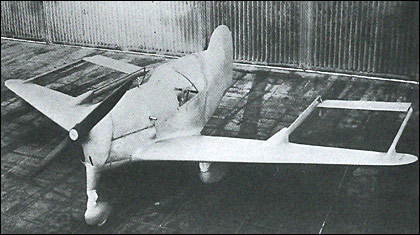|
| The Austrian aeronautical engineer Otto Kauba approached the Reichsluftministerium (RLM) with a proposal for a flying-bomb
early in 1942. The ministry was sufficiently interested in his ideas to assist in establishing the Skoda-Kauba design bureau in Prague,
Czechoslovakia. The proposed flying-bomb layout was tested in a light monoplane, the SK V1, which was written off in a crash. Two
modified aircraft, the SK V1A and SK V2, were tested before the project was abandoned in 1943.
Other designs in the series were the SK V3 light sports aircraft, the SK V4 fighter trainer, the V5 piston-engined fighter, the V6 twin-boom pusher monoplane, the V7 canard research aircraft and the V8 primary trainer, none of which entered production.
| MODEL | SK V4 |
| CREW | 1 |
| ENGINE | 1 x 240hp Argus As 10C-3 engine |
| WEIGHTS |
| Take-off weight | 1250 kg | 2756 lb |
| DIMENSIONS |
| Wingspan | 7.60 m | 25 ft 11 in |
| Length | 5.60 m | 18 ft 4 in |
| Height | 2.90 m | 10 ft 6 in |
| PERFORMANCE |
| Max. speed | 420 km/h | 261 mph |
| Ceiling | 7500 m | 24600 ft |
| Range | 900 km | 559 miles |
| ubaTaeCJ, e-mail, 21.02.2025 16:00 20 reply | | Sven, 17.12.2015 10:05 Several pictures on the net of the V4. Good looking but built for a niche that wasnt there. Realy not sure about the booms on the wing aircraft below though. Flight loads on the spar leading to a heavy wing surely? Just thought Id pitch in and cast an aviation spell reply | | Barry, 27.11.2009 15:47 The top photograph shows the the SK V4 which was the only Otto Kauba design put in to production as the SK 227. The production was somewhat limited though.
Kauba was quite revolutionary in his design approach and pioneered the use of ram-jets or specifically the designs of Eugen Saenger, however these found little favour with the RLM and the development was cancelled. reply |
|
Do you have any comments?
|
| 
All the World's Rotorcraft |






